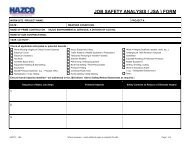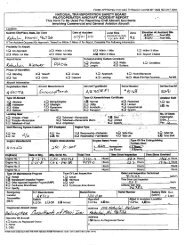International Helicopter Safety Team Safety Management System Toolkit
IHST - Safety Management Toolkit - Skybrary
IHST - Safety Management Toolkit - Skybrary
- No tags were found...
Create successful ePaper yourself
Turn your PDF publications into a flip-book with our unique Google optimized e-Paper software.
CHAPTER 3:<br />
GUIDELINES TO SMS IMPLEMENTATION<br />
Integrating a cohesive SMS can be done in incremental steps. This allows the<br />
organization to become acquainted with the requirements and results before<br />
proceeding to the next step.<br />
SMS Implementation Process<br />
0<br />
1<br />
Orientation &<br />
Commitment<br />
2<br />
Planning &<br />
Organization<br />
3<br />
Reactive<br />
Processes<br />
4<br />
Proactive<br />
Processes<br />
Continuous<br />
Improvement<br />
<strong>Safety</strong> <strong>Management</strong> <strong>System</strong>s – Flight Standards<br />
Federal Aviation Administration<br />
Courtesy of Don Arendt, PhD, FAA SMS Program Manager<br />
Developing an SMS<br />
This toolkit is a compilation of best practices<br />
and solutions. Various SMS toolkits from throughout<br />
the industry were reviewed. Contributions<br />
came from small, medium and large helicopter<br />
operators as well as airlines, industry groups and<br />
government agencies.<br />
The intent of this document is to assist organizations<br />
in achieving their desired safety performance<br />
objectives while allowing them flexibility to reach<br />
that outcome. This is commonly known as a<br />
“performance based approach” and encourages<br />
organizations to choose the solution best suited to<br />
their needs and ensures they meet performance<br />
objectives. The toolkit helps the organization determine<br />
their level of compliance and develop an<br />
action plan to include the necessary components.<br />
What Does It Take to Implement an SMS?<br />
<strong>Management</strong> initiatives are not always successful,<br />
and each time a new idea is introduced, people will ask<br />
whether this is a worthwhile initiative. Having a good<br />
idea does not guarantee success. Many good ideas<br />
have failed in practice because one or more of three<br />
critical elements were missing, including commitment,<br />
cognizance and competence. These three C’s of leadership<br />
will determine whether safety management achieves<br />
its goals and leads to a pervasive safety culture.<br />
1. Commitment: In the face of operational and<br />
commercial pressures managers need to make<br />
safety management tools effective.<br />
2. Cognizance: Leaders need to understand the<br />
nature and principles of managing safety.<br />
3. Competence: <strong>Safety</strong> management policies<br />
and procedures must be applied throughout<br />
the organization.<br />
SMS <strong>Toolkit</strong> 73







